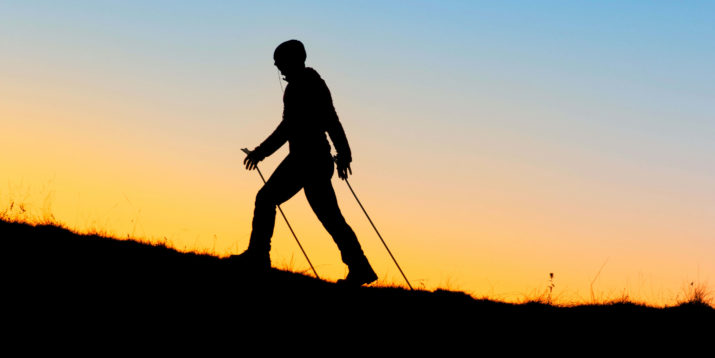Nordic Walking: How to Burn 20 Percent More Calories on Your Next Hike

“Where are your skis?”
That’s the first question people usually ask when they see walkers trudging along holding poles during a hike, long walk, or all-terrain ramble. Like cross-country skiing, Nordic walking incorporates specialized poles to propel the walker forward, encouraging the use of upper body muscles.
But unlike cross-country skiing, Nordic walking is suitable in any weather. You can also safely, comfortably do it anyplace where you would otherwise hike, walk, or trek.
Benefits of Nordic Walking
It Burns More Calories
Nordic walking was originally developed in the 1930s by cross-country skiers looking to train off-season, according to Gill Stewart in The Complete Guide to Nordic Walking. “It’s an enhancement of ordinary walking that ensures that the whole body shares the workload,” writes Stewart, program director at Nordic Walking U.K.
Although it’s often confused with trekking, Nordic walking requires specialized poles designed not for balance, but rather to propel the body forward with greater speed and to better engage muscles in the upper body. In so doing, they turn an activity that normally just targets the legs into a calorie-incinerating, full-body workout.
Just how many more calories you’ll burn pumping your upper body as hard as your lower body is a matter of debate (every Nordic association seems to boast its own numbers). But a study by the Cooper Institute found that Nordic walking burned about 20 percent more calories than regular walking.
It Builds Upper Body Strength
By outsourcing more movement to the arms, back, and shoulders, Nordic walking uses 90 percent of your muscles. Ordinary walking utilizes just just 70 percent.
One international study found upper body muscle activation is two to 15 times higher than with ordinary walking. A 2013 study of women in a Nordic walking group found significant positive differences in muscle strength and skeletal muscle mass, suggesting the activity could help with your body shaping goals.
It’s Low Impact
Nordic walking can get your heart up as high as jogging, without the proportionate stress on the body. Subsequently, a 2011 Japanese study found it caused less shock to the lower back, hips, and knees than ordinary walking.
In small European studies, Nordic walking has also been shown to potentially:
• Improve posture
• Increase production of “feel good” hormones
• Promote muscular endurance in the arms and shoulders
• Tighten core muscles and buttocks
• Decrease neck and shoulder tension
• Enhance mood and feelings of well-being

How to Do Nordic Walking
Don’t be scared or put off. Nordic walking is just an “enhancement of normal walking,” according to the Nordic Academy, Australia’s professional community.
The Equipment
You don’t need much gear, but the right poles are essential. Nordic poles differ from trekking poles in that they’re designed for propulsion rather than stability. As a result, they more closely resemble cross-country ski poles, with a special strap that enables the push-and-release motion that differentiates Nordic walking from trekking, which promotes poles with straps designed more to prevent loss of the pole than to aid technique.
Further, Nordic walking poles are outfitted with tips designed to facilitate the backward angle at which they’re held, while the tips on trekking poles are typically straight. And, while both are manufactured in telescoping, one-size-fits-all versions, Nordic poles also offer fixed lengths to suit the walker’s height.
The Technique
- The basic movement is similar to ordinary walking—opposite arms and legs move together (i.e., left arm and right leg, right arm and left leg).
- With each step, swing the opposite pole forward, keeping it diagonal to the ground as you plant the tip halfway between your front and rear feet.
- Maintain a loose grip on the upswing, then tighten it as you plant the pole and push backward for propulsion.
- Keep your shoulders relaxed, not hunched, and your upper body leaning slightly forward.
- Roll your foot from heel to ball with each step.
Almost every country has a Nordic Walking Association, which is a good place to start and meet other interested walkers.
Surely, any kind of walking can help people improve quality of life and enjoyment of daily physical activity. But Nordic walking packs an extra punch with those poles, and the steady cardio activity makes for an effective cross-training tool on recovery days between intense workouts.
